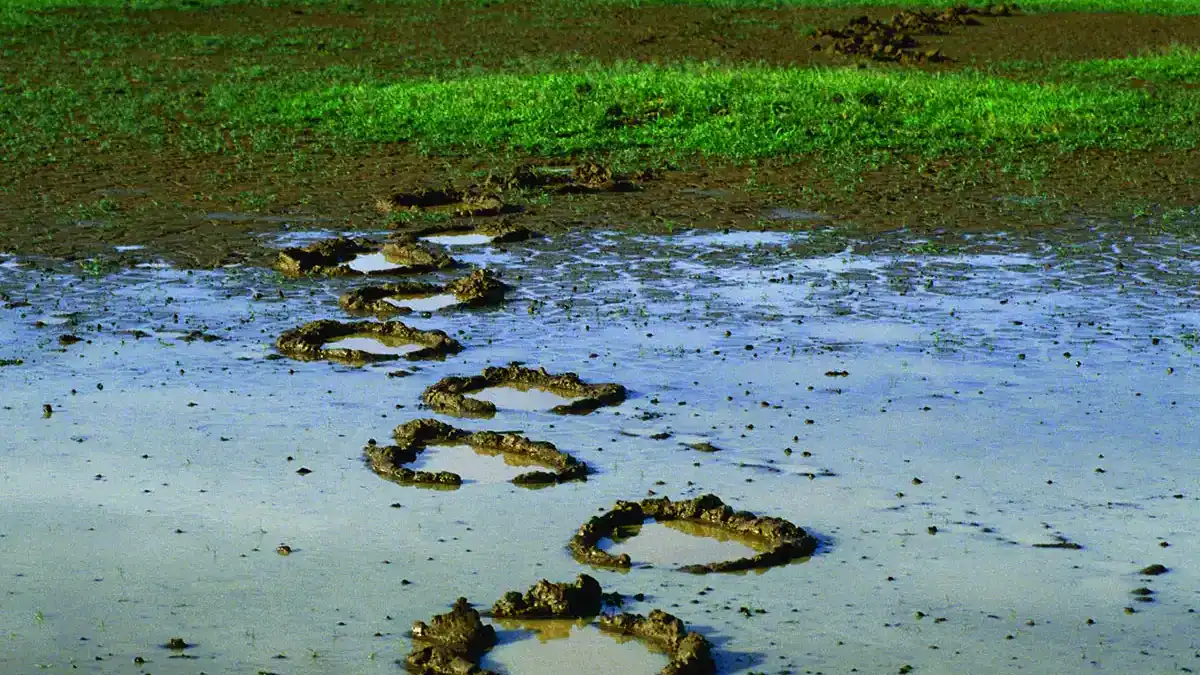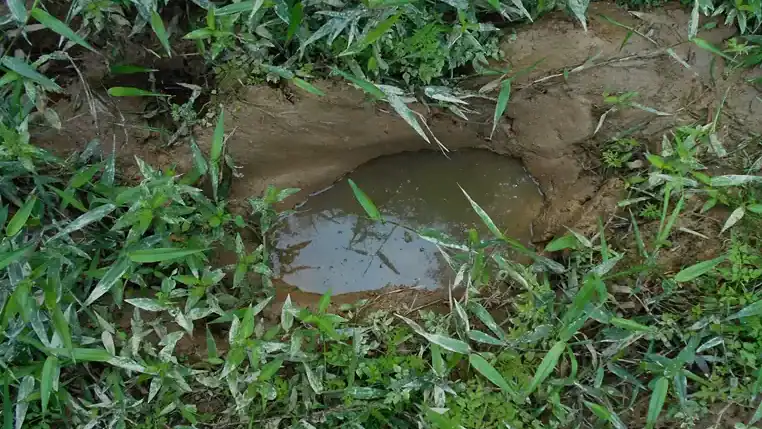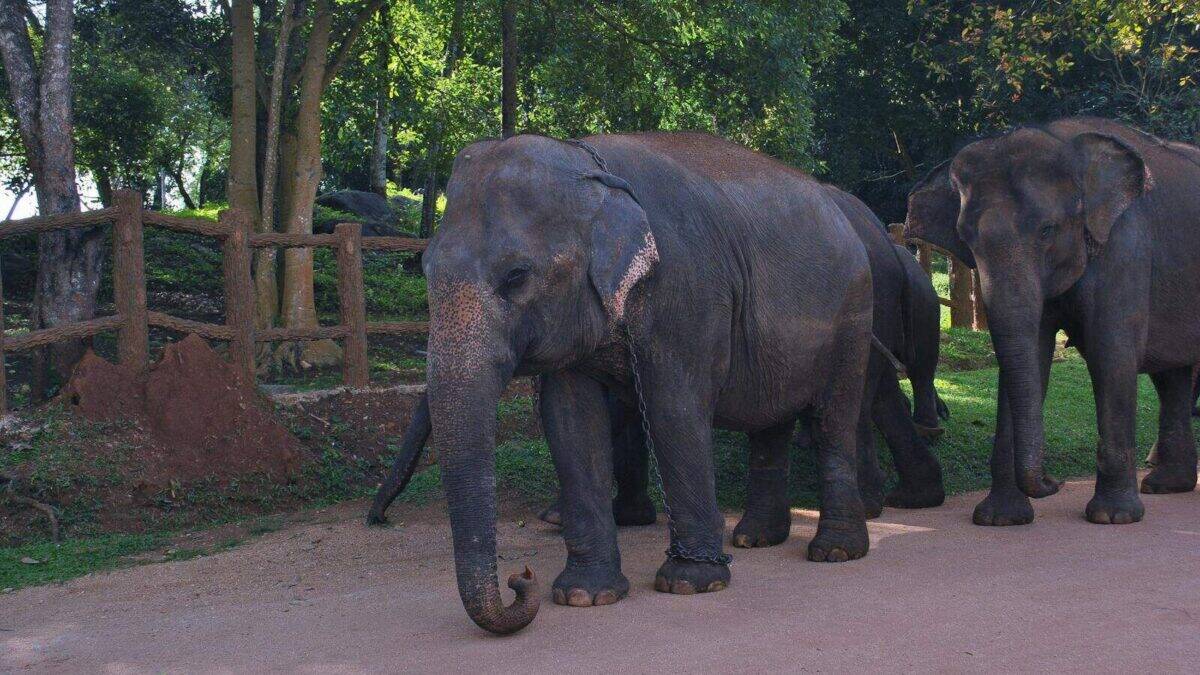In the vast landscapes of African savannas and Asian forests, elephants trek across miles of terrain each day, leaving behind more than just massive footprints in their wake. These gentle giants, weighing up to 13,000 pounds, create depressions in the earth that can be up to 18 inches deep and persist through changing seasons. While the immediate purpose of these footprints might seem insignificant, they actually form an intricate web of microhabitats and safety corridors that benefit countless other species.
Elephants are already known as ecosystem engineers – animals that physically modify their environment in ways that create or maintain habitats for other species. Their role in seed dispersal, vegetation management, and water access is well documented. However, recent scientific studies have revealed that even their footprints serve a critical ecological function, creating temporary oases and navigation pathways that smaller animals utilize for survival, particularly in harsh conditions.
Nature’s Water Bowls

Perhaps the most immediately obvious benefit of elephant footprints is their capacity to collect and hold water. In dry regions across Africa and Asia, these natural depressions fill with rainwater, creating miniature pools that can persist for days or even weeks after a rainfall. These ephemeral water sources become critical survival points for smaller animals during dry seasons. Researchers have documented everything from insects and amphibians to small mammals and birds utilizing these footprint-pools as drinking stations.
During prolonged dry periods, these water-filled footprints can be the difference between life and death for many species. A single elephant can create hundreds of these natural water bowls during a day’s journey, effectively transforming parched landscapes into networks of life-sustaining microhabitats. The importance of these water sources increases exponentially in regions where permanent water bodies may be separated by many miles of arid terrain.
Amphibian Nurseries

For amphibians like frogs and toads, elephant footprints serve as more than just drinking spots – they become crucial breeding grounds. Scientists studying African elephants in Uganda and Kenya have documented several frog species that specifically seek out water-filled elephant tracks for reproduction. These natural depressions provide protected environments where tadpoles can develop, shielded from many predators that inhabit larger water bodies.
The temporary nature of these pools also works in the amphibians’ favor, as many species have evolved rapid development cycles that allow their offspring to metamorphose before the water evaporates. Research published in the journal African Journal of Ecology found that some frog species can complete their entire metamorphosis within the lifespan of a water-filled elephant track, which may be as short as 7-10 days in hot conditions. This adaptation highlights the long evolutionary relationship between elephants and the smaller creatures that benefit from their movements.
Insect Highways

The depressions created by elephant feet serve as more than just water collectors – they also function as navigation corridors for insects. Ants, beetles, and other ground-dwelling arthropods use these indentations as pathways through otherwise challenging terrain. The compact soil at the bottom of footprints provides a smoother surface for travel, while the walls of the depression offer protection from wind and some predators.
Entomologists studying this phenomenon have observed that certain ant species preferentially construct their foraging trails along chains of elephant footprints, especially in areas with loose sand or thick vegetation. These natural highways reduce the energy expenditure required for the insects to travel between food sources and their colonies. In a fascinating example of interconnected ecology, the insects using these pathways often become food sources themselves for birds and small mammals that have learned to hunt along elephant trails.
Predator Avoidance Markers

For prey animals in elephant ranges, footprints serve as indirect warning systems about potential predator presence. Many predators in African and Asian ecosystems – including lions, hyenas, and tigers – have learned to use elephant-created paths for their own hunting and travel. The large, recognizable depressions left by elephants can alert smaller animals to recent activity along a path. Fresh footprints with disturbed edges might indicate recent passage of not just elephants but potentially the predators that follow them.
Behavioral studies of gazelles, impalas, and other ungulates show increased vigilance behaviors when encountering fresh elephant tracks. These prey species appear to use the age and condition of elephant footprints as one of several environmental cues that help them assess predation risk in their surroundings. Some researchers believe this represents a sophisticated form of information gathering that helps smaller animals navigate their environment more safely.
Seed Dispersal Enhancement

Elephants are already renowned as important seed dispersers, consuming fruits and vegetation and depositing the seeds in their dung far from the parent plants. However, their footprints add another dimension to this ecological service. When rain fills elephant tracks, these depressions become ideal germination sites for certain plant species. The compacted soil provides stability, while the collected water offers the moisture necessary for seeds to sprout.
Botanists have observed that some plant species show higher germination rates in and around elephant footprints compared to undisturbed soil. The depression protects seeds from being washed away by heavy rains and can trap windblown seeds that might otherwise land on less hospitable ground. This footprint-facilitated seed dispersal helps maintain plant diversity and contributes to habitat regeneration, especially in areas where elephants have foraged on vegetation.
Microhabitat Creation

Each elephant footprint represents a unique microhabitat with its own environmental conditions. The depression changes temperature, humidity, and light exposure compared to the surrounding terrain. These altered conditions create ecological niches that support species that might otherwise struggle in the broader environment. In hot climates, the shade within deeper footprints can reduce temperatures by several degrees, providing critical refuges for heat-sensitive organisms.
The diversity of life found within these microhabitats is remarkable. Scientists conducting biodiversity surveys of water-filled elephant tracks have documented dozens of microscopic species in a single footprint, including protozoans, nematodes, rotifers, and various insect larvae. These tiny ecosystems function as stepping stones that allow smaller organisms to populate and traverse landscapes that would otherwise be inhospitable barriers.
Trail Networks and Migration Safety

Over generations, elephant herds often follow the same migratory routes, creating well-worn paths through diverse landscapes. The footprints along these established trails form recognizable patterns that smaller migratory animals can follow. For species that must travel between seasonal feeding grounds or water sources, these elephant-maintained pathways offer safer passage through difficult terrain. Researchers tracking wildlife movements have noted that many birds and mammals preferentially travel along elephant-created trails.
During migrations, following these established routes reduces the risk of encountering unexpected obstacles or becoming disoriented in unfamiliar territory. For young animals learning migration patterns, the clear visual markers of elephant paths provide essential navigational guidance. In regions where habitat fragmentation threatens traditional migration corridors, elephant-maintained trails sometimes represent the last remaining safe passages between isolated habitat patches.
Soil Composition Changes

The physical impact of elephant feet on soil creates changes that extend beyond the visible depression. The tremendous pressure – up to 60 pounds per square inch – compacts soil particles and alters the subsurface structure. This compaction changes how water moves through the soil profile and can create zones of different moisture retention. Some burrowing animals specifically seek out soil near elephant tracks for their homes because the altered composition makes digging easier or provides structural stability.
Soil scientists studying these effects have documented significant differences in microbial communities between elephant-tracked areas and undisturbed ground. The compaction process breaks down organic matter differently and can expose deeper soil layers to the surface. These changes can persist for months or even years after the elephant has passed, creating lasting effects on local ecology and providing ongoing benefits to other species that require specific soil conditions.
Thermal Refuges

In tropical regions with intense sun exposure, elephant footprints provide critical thermal refuges for small animals. The depth of the depression creates shade patterns that shift throughout the day, offering protection from direct sunlight. This temperature moderation can be life-saving during extreme heat events. Thermal imaging studies have shown that during midday heat, the temperature inside elephant tracks can be up to 15°F cooler than surrounding exposed surfaces.
Reptiles like small lizards and snakes particularly benefit from these thermal refuges. Researchers have observed these animals moving between footprints throughout the day, regulating their body temperature by taking advantage of the varied microclimate conditions. For cold-blooded creatures, this temperature regulation opportunity improves hunting efficiency, reproductive success, and overall survival. Even mammals have been documented using deeper footprints as temporary cooling spots during the hottest parts of the day.
Cultural Transmission of Knowledge

Perhaps one of the most fascinating aspects of how animals use elephant footprints involves the cultural transmission of this knowledge. Within social species that live alongside elephants, younger animals learn from older, experienced individuals about how to utilize these landscape features. Primates like baboons and vervet monkeys have been observed teaching their young which elephant tracks make good water sources and which might be too old or contaminated.
This passing of environmental knowledge represents a sophisticated form of adaptation that allows multiple generations to benefit from elephant activities. The cultural learning extends to seasonal patterns as well – in some regions, animals have learned to follow fresh elephant tracks immediately after the first rains of the season, knowing that these will lead to newly filled water sources. This knowledge transmission highlights the complex interdependencies that have evolved between elephants and the many species that share their ecosystems.
Conservation Implications

Understanding the ecological importance of elephant footprints has significant conservation implications. As elephant populations decline due to poaching, habitat loss, and human-wildlife conflict, their absence creates ripple effects throughout ecosystems. Without their footprints creating water catchments and microhabitats, numerous smaller species face increased survival challenges, particularly during drought conditions or climate change-induced weather extremes.
Conservation efforts increasingly recognize that protecting elephants means protecting entire ecological networks that depend on their presence. Some wildlife management strategies now include creating artificial depressions to mimic elephant footprints in areas where elephant populations have been reduced or eliminated. While these human-made alternatives cannot fully replace the dynamic nature of elephant movements, they represent attempts to maintain some of the ecological functions that elephant footprints provide for countless other species.
A Testament to Nature’s Interconnectedness

The remarkable story of how elephant footprints help other animals navigate safely illustrates the profound interconnectedness of nature’s systems. From microscopic organisms to large mammals, countless species have adapted to utilize these temporary landscape features in ways that enhance their survival. This ecological relationship has evolved over millions of years, creating dependencies that highlight the importance of maintaining intact ecosystems with their keystone species.
As we continue to study these interactions, we gain deeper appreciation for how the seemingly simple act of an elephant walking through its habitat creates cascading benefits for biodiversity. The footprints left behind serve as more than just evidence of an elephant’s passage – they represent nature’s ingenious way of maximizing resources and creating opportunities even in challenging environments. The humble elephant footprint reminds us that in nature’s economy, nothing is wasted, and even the most temporary features can sustain the web of life.
For conservation science, these insights emphasize the importance of preserving not just individual species but the ecological processes they facilitate. As elephant populations face ongoing threats, protecting them means safeguarding the myriad subtle ways they engineer their environments. In the end, the story of elephant footprints and the creatures that use them is a powerful reminder that in healthy ecosystems, every species plays roles far more complex and important than we might initially recognize.
These natural connections, formed over evolutionary time, demonstrate nature’s elegant solutions to environmental challenges – solutions we are only beginning to fully understand and appreciate. By studying and protecting these relationships, we gain not only scientific knowledge but also insights into sustainable systems that have withstood the test of time.
- 10 Record-Breaking Animals That Hold the Title for Biggest, Fastest, and Strongest - August 15, 2025
- What Makes Pufferfish Inflate? - August 15, 2025
- Meet the Bee Hummingbird: The Smallest Bird Alive - August 15, 2025

